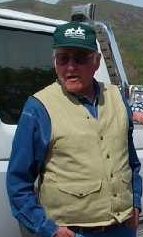Paul Rokich grew up near a canyon in Utah's Oquirrh Mountains. The canyon was called desert asphalt: There were no birds, no animals, no flowers, no trees, no streams. That was because the area was dominated by smelters from the Kennecott Copper Corporation. The effluent, the pollution, the continuous emissions from the smelters made the thousands of acres around Rokich's home a wasteland. Rokich remembers that when he was but six years old, he looked out over the land and saw only two trees, and they were both dead.
"At that moment I knew without a doubt what my future was," he recalls. "I promised myself that, one day, I would climb that mountain and replant the trees."
He started, innocently enough, by visiting Kennecott's office to see if they might bring back the trees, or, failing that, if he might be allowed to try. No, thank you, was the response, and he was shown the door.
Cut ahead about 15 years. After studying botany at the University of Utah, Rokich was even more determined to reclaim the wasteland, even though everyone at the university said it was impossible: The trees can't grow, and the seeds can't be dispersed without birds and animals. At a conservative estimate, it would take 20,000 years to make the six square miles green again, Rokich was told.
So he stole away in the night, trespassed on Kennecott land, and planted a seedling for a Russian olive tree. Then he walked the land for seven more hours, planting more seedlings. That was essentially his life for the next several years. He began at 4:00 in the morning, hiked and planted for most of the day and night, and hoped things would grow. At first, the effort didn't go well: three out of every four seedlings died. But then, slowly, some seedlings took root.
A shrub began to bloom. Then came more shrubs: elderberry, sagebrush, and bitterbrush. Then the trees: aspen, fir, and maple. Rokich's former professor was amazed. Rokich had reforested 100 acres.
On one of his forays into his new forest, Rokich found a poplar on its side, the roots dissolved. He was heartbroken at first, but then realized to his astonishment that the roots have been eaten away by a gopher. The animals had returned: not only gophers, but rabbits and porcupines, too. And then came deer, elk, golden eagles, and partridges.
There were setbacks: One time, a highway crew hauled away tons of earth from the area. Another time, one of his tree farms, which had taken three months of eight-hour trips with his pack mule to seed, was burned to the ground from a sheepherder's campfire—three thousand Douglas firs and ponderosa pines went up in smoke.
Rokich continued his efforts despite the setbacks and the financial drain. He and his wife and children were dirt-poor, and he'd borrowed money from relatives and begged donations from seed companies, garden stores, and the university.
But then came a change. Kennecott was adapting to the times, more specifically, to new environmental laws: In 1973, the company hired Rokich to do what he'd been doing all those years. So now Rokich had help: He had crews, he had vehicles. He even had a helicopter. The replanting got a tremendous boost.
By 1990, Rokich's vision had been achieved. He'd planted 60,000 trees, the largest of which was now 25 feet tall. Kennecott had set aside $500,000 for reclamation work.
"You know," he said, "I thought that if I got this started, when I was dead and gone, people would come and see it. I never thought I'd live to see it myself."
The area is now a forest, where once there was a desert. A Kennecott executive gave Rokich the credit: "Sure, the company would have done revegetation work. But it wouldn't be anywhere as far along without a guy like Paul. He's truly a zealot."
Zealot or not, Rokich now enjoys his new world. During one interview, he stretched his arms wide, as if trying to embrace everything: the trees, the birds, the swaying grass. "I'm amazed, he said. Look at what I've done. What more could you want?"

